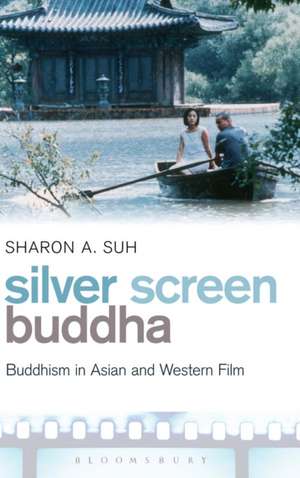Silver Screen Buddha: Buddhism in Asian and Western Film
Autor Dr. Sharon A. Suhen Limba Engleză Hardback – 28 ian 2015
| Toate formatele și edițiile | Preț | Express |
|---|---|---|
| Paperback (1) | 218.00 lei 6-8 săpt. | |
| Bloomsbury Publishing – 28 ian 2015 | 218.00 lei 6-8 săpt. | |
| Hardback (1) | 773.45 lei 6-8 săpt. | |
| Bloomsbury Publishing – 28 ian 2015 | 773.45 lei 6-8 săpt. |
Preț: 773.45 lei
Preț vechi: 991.02 lei
-22% Nou
Puncte Express: 1160
Preț estimativ în valută:
148.02€ • 153.23$ • 125.11£
148.02€ • 153.23$ • 125.11£
Carte tipărită la comandă
Livrare economică 05-19 martie
Preluare comenzi: 021 569.72.76
Specificații
ISBN-13: 9781441189257
ISBN-10: 1441189254
Pagini: 232
Ilustrații: 15 bw illus
Dimensiuni: 156 x 234 x 14 mm
Greutate: 0.5 kg
Editura: Bloomsbury Publishing
Colecția Bloomsbury Academic
Locul publicării:London, United Kingdom
ISBN-10: 1441189254
Pagini: 232
Ilustrații: 15 bw illus
Dimensiuni: 156 x 234 x 14 mm
Greutate: 0.5 kg
Editura: Bloomsbury Publishing
Colecția Bloomsbury Academic
Locul publicării:London, United Kingdom
Caracteristici
Enables readers to establish whether the representation of Buddhism is realistic or exoticized
Notă biografică
Sharon A. Suh is Associate Professor and Chair of the Department of Theology and Religious Studies at Seattle University, USA.
Cuprins
1. Introduction: Buddhism and Film2. Longing for Otherness through Buddhism3. Zen Appetites: Consuming Religion and Otherness through Film4. Plus ça change, plus c'est la même chose: Women as Snares of Samsara5. Coming Down from the Mountaintop: Engaged Buddhism in the World6. The Ordinary as Extraordinary7. Film as Sutra8. Toward a Re-Visioning of the Role of Lay Women in Buddhism9. Conclusion: Re-creating the Buddhist World Anew-But in Whose Image?BibliographyIndex
Recenzii
Silver Screen Buddha is a gem of a book. And Sharon Suh is a cultural critic of the highest order. With this book, Suh has emerged at the forefront of cultural studies of religion. Through lucid prose and provocative insights, Suh provides vivid access to the embodied spiritual economies of lay Buddhist lives. Her deep dive into film widens our engagement with the cultural imaginary of Buddhism well beyond the rarefied and stubbornly Orientalist accounts of ascetic meditation practices. By rightfully demanding that we draw our attention to the funk and mess of ordinary Buddhist practice, Suh reveals paths that are singular and utterly invaluable for understanding the mutual world making of film and everyday religious life. What an achievement!
Suh's provocative analysis of the "hidden transcripts" of Buddhist film turns the cinematographic lens on producer, director, viewer, and viewed. Her evocative prose places critical analysis alongside artistic imagery in imaginative juxtaposition. Is Buddhism the sum of its portrayals or something different altogether?
Sharon Suh invites the reader to re-imagine Buddhism through the lens of film, a genre that is too often dismissed as 'entertainment'. She offers fresh insights that illuminate previously overlooked dimensions of Buddhist thought and culture in vivid and original terms.
A strength of "Silver Screen Buddha" is certainly the heterogeneity of the sample of movies it analyzes. Suh explores movies from the beginning of the 20th century together with contemporary ones, and American movies together with Asian ones; furthermore, she not only elaborates a criticism of Buddhist representations, but she also offers an analysis of movies that realistically describe Buddhist practices and lifestyles.
Suh's provocative analysis of the "hidden transcripts" of Buddhist film turns the cinematographic lens on producer, director, viewer, and viewed. Her evocative prose places critical analysis alongside artistic imagery in imaginative juxtaposition. Is Buddhism the sum of its portrayals or something different altogether?
Sharon Suh invites the reader to re-imagine Buddhism through the lens of film, a genre that is too often dismissed as 'entertainment'. She offers fresh insights that illuminate previously overlooked dimensions of Buddhist thought and culture in vivid and original terms.
A strength of "Silver Screen Buddha" is certainly the heterogeneity of the sample of movies it analyzes. Suh explores movies from the beginning of the 20th century together with contemporary ones, and American movies together with Asian ones; furthermore, she not only elaborates a criticism of Buddhist representations, but she also offers an analysis of movies that realistically describe Buddhist practices and lifestyles.










